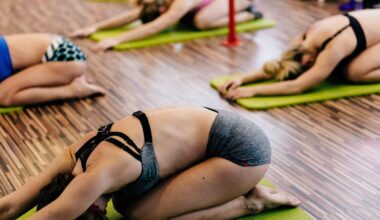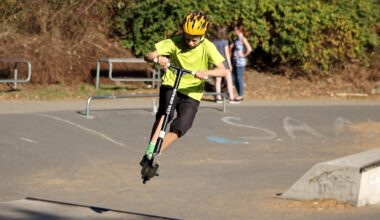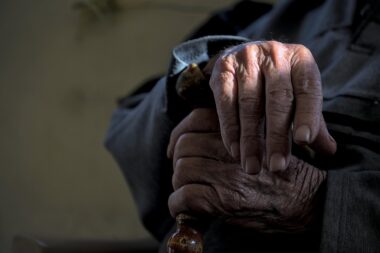Integration of Multisensory Inputs in Maintaining Senior Balance
As individuals age, their balance often becomes compromised due to various physiological changes. The interplay of visual, vestibular, and proprioceptive systems is crucial for maintaining stability. Poor balance increases the risk of falls, which is a major concern for older adults. A fall can lead to severe consequences, including fractures and limited mobility. The aging process often diminishes these sensory inputs, leading to decreased responsiveness in balance. It is vital for seniors to engage in activities that enhance their multisensory integration, thus fostering better balance. Activities like tai chi or yoga can support the incorporation of multiple sensory inputs. These practices help strengthen muscles while improving coordination and balance skills. Additionally, exercise promotes neural plasticity, allowing the elderly to adapt to changes effectively. Incorporating balance-focused exercises into daily routines can diminish the effects of aging on these sensory systems. Addressing balance early can significantly enhance quality of life in older adults. Creating supportive environments that foster safe movement is equally essential. By combining mindfulness and movement, seniors can achieve better control over their balance and coordination, essential skills for maintaining independence as they grow older.
The age-related decline in balance is influenced by various factors that can be targeted through lifestyle interventions. Sensory systems provide the foundation for maintaining stability, yet aging often hampers their effectiveness. For seniors, the visual system may become less sharp, leading to a reliance on other senses to compensate. Moreover, the vestibular system, which contributes to balance through spatial orientation, may decline with age. Proprioception, the body’s ability to sense its position, can also weaken, leading to instability. These inherent changes necessitate strategies aimed at enhancing sensory input. Engaging in balance-training exercises can stimulate the proprioceptive senses and improve body awareness. Programs designed specifically for seniors often include strength training, stability exercises, and flexibility training. These components work collaboratively to enhance the body’s response to instability. Educational resources should promote awareness on the significance of active aging. It’s essential for older adults to seek out information on maintaining their balance, fostering independence through movement. Gathering support from healthcare providers and community programs can provide critical assistance in implementing effective strategies. Strengthening the bond between sensory inputs and balance functions is arguably one of the most powerful defenses against the challenges posed by aging.
The Role of Visual Inputs in Balance
Visual inputs are critical for maintaining balance, particularly as one ages. The eyes help to gauge spatial awareness and provide critical feedback to the brain regarding body positioning. As we grow older, vision can decline, influencing the ability to maintain balance effectively. Proper lighting and visual environments can enhance safety and mobility for seniors, helping them to navigate independently. Engaging in activities that require focused visual attention can stimulate visual processing. Moreover, using contrast and colors in environments can support better visibility, improving spatial awareness. Regular eye examinations ensure that any vision-related issues are addressed promptly. Furthermore, ensuring that seniors are aware of their specific visual limitations can empower them to adapt their movements accordingly. Incorporating visual cues in ordinary environments can significantly aid in navigating space safely. For instance, using marks on floors or walls can guide elderly individuals in maintaining their stability. Hence, recognizing and addressing vision challenges becomes essential to preserve balance functionality. Engaging seniors in visual-skills training can foster better adaptability and awareness of their surroundings, ultimately fortifying their balance capabilities. Enhancing these aspects mitigates fall risks and enhances overall safety within communities.
The vestibular system also plays a vital role in maintaining balance, particularly for the elderly. This sensory system, located in the inner ear, detects motion and changes in head positioning. With age, vestibular function may decline, impairing one’s balance capabilities. Thus, seeking activities that stimulate vestibular responses can be beneficial for older adults. Exercises such as head tilts, balance beams, or simple walking while changing direction can enhance vestibular processing. Targeting dynamic balance skills is important, as falling leads to injuries that significantly impact senior independence. Engaging in rhythmic movements, such as dancing or swimming, can provide enjoyable means to stimulate vestibular functions. Effective rehabilitation programs designed for seniors should place equal emphasis on stimulating their vestibular system and improving overall strength. By incorporating vestibular stimulation into their routines, older adults can develop better responses to balance challenges. Comprehensive approaches that address sensory system engagement are key in managing age-related balance issues. Combining this with education on environmental safety can further mitigate fall risks. Consequently, understanding the nuances of vestibular function can empower seniors to maintain control over their mobility and overall quality of life.
Enhancing Proprioceptive Awareness
Proprioception, the sense of body positioning, is essential for maintaining balance, especially as individuals age. This sensory input allows individuals to be aware of their limbs’ positions, even without visual cues. With aging, proprioception may reduce, contributing to instability and increased fall risk. Engaging in exercises that specifically target proprioceptive abilities can lead to significant improvements in balance. Balance boards, stability balls, and single-leg stands are excellent tools for enhancing body awareness. Incorporating these devices into regular exercise routines can help seniors become more attuned to their body’s movements. As their proprioceptive abilities improve, seniors will likely experience greater confidence and stability. Additionally, mindfulness practices such as tai chi can support proprioceptive awareness while fostering relaxation. Encouraging participation in group exercise classes creates a sense of camaraderie while enhancing physical skills. Implementing skills-based training into community programs ensures that seniors receive support in maintaining their proprioceptive functions. Active engagement in proprioception-focused activities can ultimately improve balance and coordination, significantly alleviating fears of falling. Empowering seniors to take charge of their physical well-being deepens their connection to movement, encouraging enjoyment in active lifestyles.
Creating an environment conducive to balance is also essential for older adults. Many structures and communities can be redesigned to support those with balance challenges. Implementing simple modifications such as removing tripping hazards, adding handrails, or ensuring adequate lighting helps in promoting safety. Establishing clear walking paths free from obstacles is fundamental for seniors to navigate their environment independently. Community awareness about balance-related issues can engender supportive systems for older adults. Encouraging local organizations to host fall-prevention seminars and workshops increases knowledge and empowers seniors. Public spaces should be designed considering sensory integration, accommodating the needs of those who may have compromised balance. Good design ensures accessibility and safety for all individuals, fostering an inclusive environment. These modifications not only minimize risks but also promote active participation in community activities, thus enhancing quality of life. Enabling seniors to mitigate challenges while navigating their environment fosters a sense of empowerment. Incorporating technology, such as sensory alarms, can further enhance safety measures for the elderly. Ultimately, a committed approach to environmental safety tailored to seniors’ specific needs significantly contributes to maintaining their balance throughout their aging journey.
The Importance of Regular Assessment
Regular assessment of balance and sensory integration systems is crucial for addressing the effects of aging. Healthcare professionals should implement routine checkups focusing on stability and motor skills. Early identification of balance-related issues can enable timely interventions that may prevent severe consequences from falls. Implementing standardized balance and coordination tests allows for effective monitoring over time. Seniors participating in these assessments can receive personalized recommendations to bolster their balance and overall physical health. Reassessing balance periodically encourages seniors to remain engaged and aware of their physical capabilities. These assessments can also stimulate discussions around lifestyle modifications that support balance improvement. Awareness of the natural aging process can ease anxiety related to balance limitations. Regular engagement with healthcare providers fosters a collaborative approach to health. By getting assessed regularly, older adults can track progress, celebrate achievements, and identify areas for improvement. Community outreach initiatives should promote assessments and provide seniors with resources tailored to their specific challenges. Promoting a proactive stance on balance can enhance not only physical health but also emotional well-being. Thus, striking a balance between physical assessments and community support can empower older adults to maintain robust independence as they age.
Conclusion: Emphasizing Multisensory Integration
In conclusion, addressing the effects of aging on balance requires a multifaceted approach. Recognizing how visual, vestibular, and proprioceptive systems interact is crucial in maintaining stability as seniors age. Engaging in exercises tailored to strengthen these systems can enhance overall balance and coordination. The integration of sensory inputs fosters better self-awareness and confidence in performing daily activities. Addressing the risks associated with falling necessitates regular evaluations to promote safety. Communities, healthcare providers, and seniors must collaborate to formulate effective strategies for improvement. Establishing supportive environments helps individuals navigate their surroundings safely. Encouraging active lifestyles can empower seniors to embrace their independence, enhancing their overall quality of life. By remaining aware of balance issues, seniors can effectively adapt to their needs as they age. The importance of education and awareness cannot be overstated, with resources tailored to promoting balance and coordination readily available. Overall, effective strategies that incorporate multisensory inputs are essential in ensuring seniors lead fulfilling lives while mitigating the risks associated with balance-related issues.





